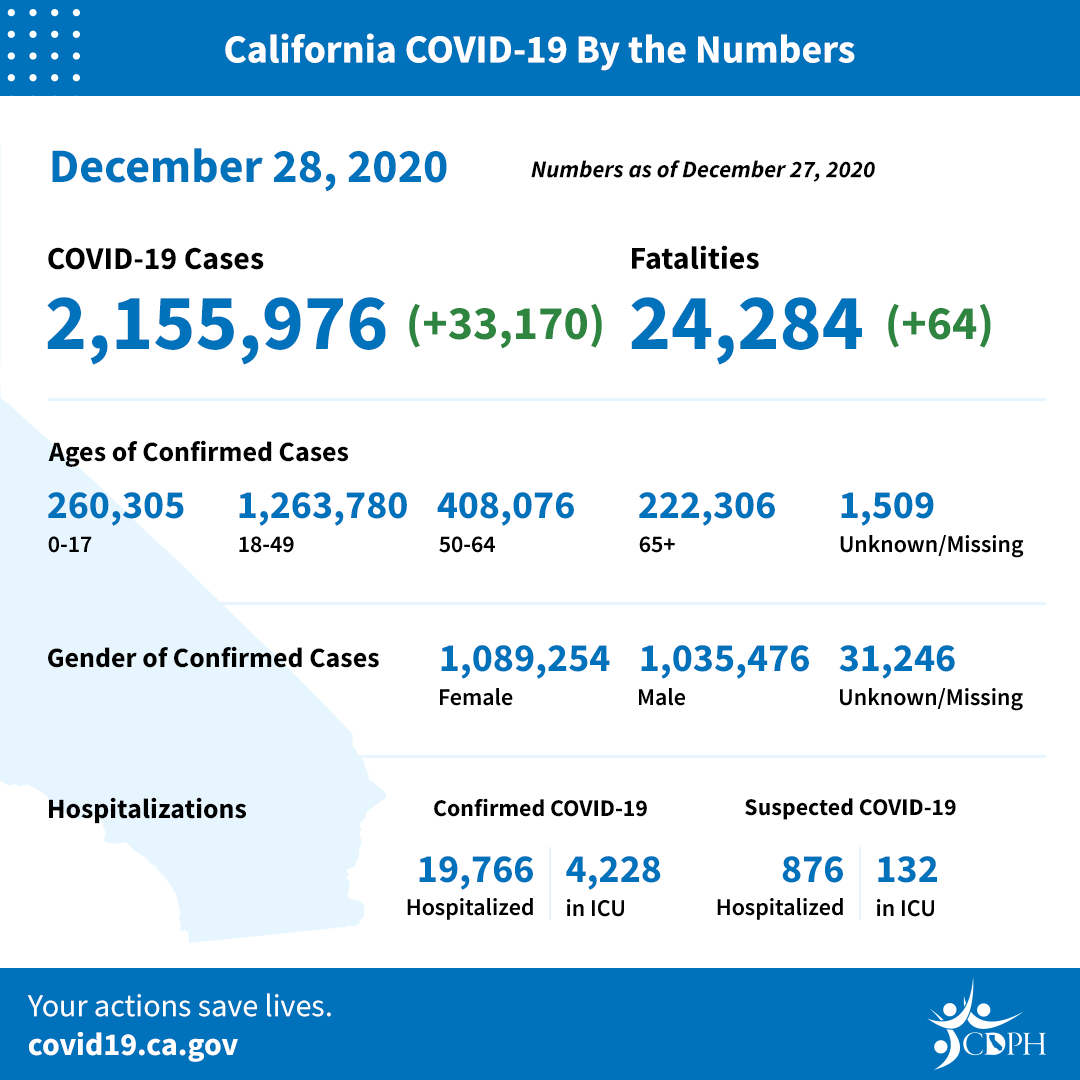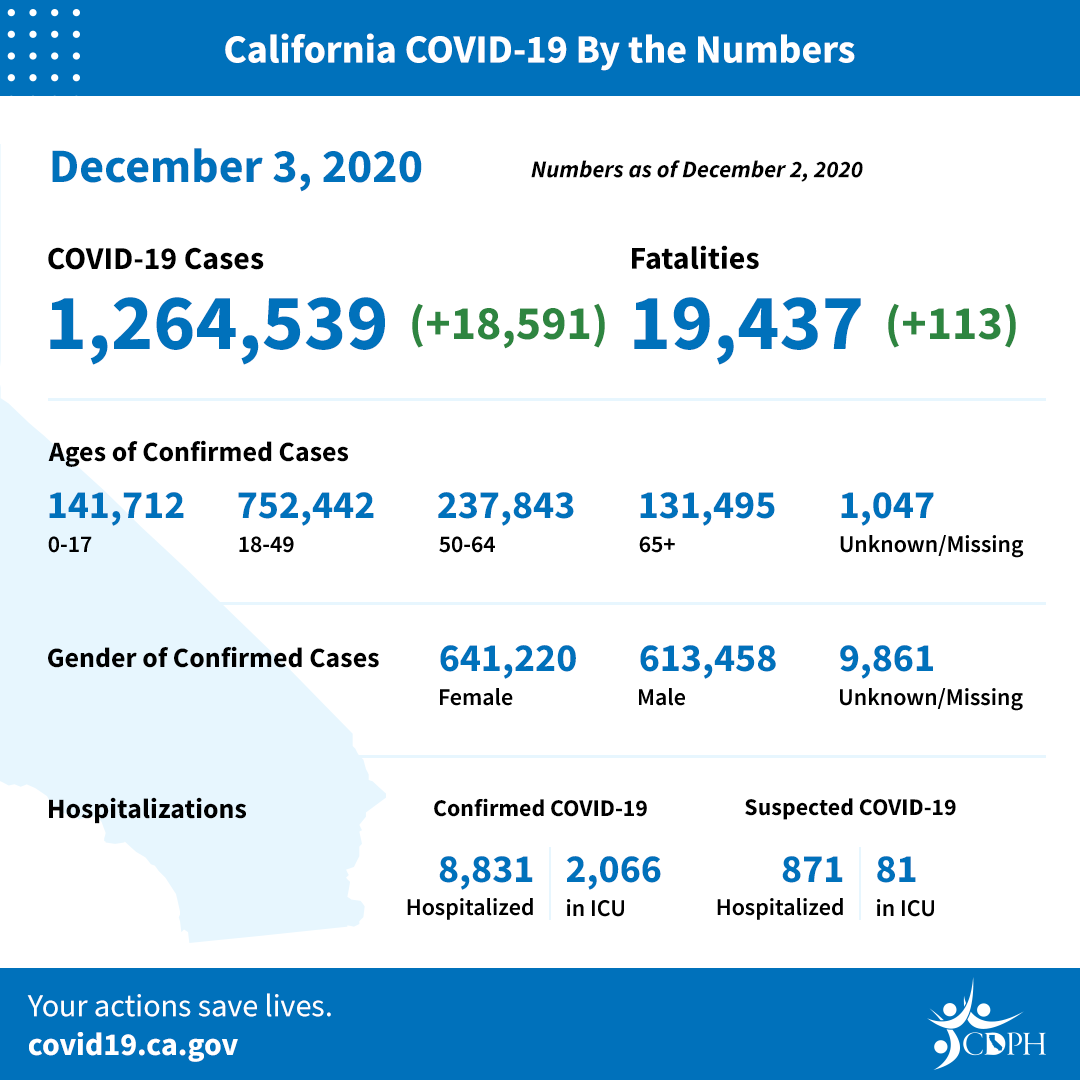State Officials Announce Latest COVID-19 Facts
Date: December 28, 2020
Number: NR20-351
Contact: CDPHpress@cdph.ca.gov
CDPH Provides Direction on Implementation of Crisis Care Continuum Guidelines
During the Current Surge of COVID-19 Cases
SACRAMENTO – The California Department of Public Health (CDPH) announced the most recent statistics on COVID-19, including data on intensive care unit (ICU) capacity across the state.
Based on ICU data, four regions, San Joaquin Valley, Southern California, Greater Sacramento and the Bay Area continue under the Regional Stay at Home Order. The Regional Stay at Home Order shall continue until ICU capacity projections are sustained above or equal to 15%.
The earliest dates that regions may be eligible to exit are:
- San Joaquin: 4-week ICU projections to be announced 12/29
- Southern California: 4-week ICU projections to be announced 12/29
- Greater Sacramento: January 1
- Bay Area: January 8
Current available ICU capacity by region:
- Bay Area: 9.5%
- Greater Sacramento: 16.6%
- Northern California: 29.3%
- San Joaquin Valley: 0.0%
- Southern California: 0.0%
Due to high rates of COVID-19 hospitalizations impacting the health care system, California is under a Limited Stay at Home Order. The order applies to all counties that are currently under the Regional Stay at Home Order and those in Tier One (Purple) of the Blueprint for a Safer Economy. The Limited Stay at Home Order will expire after the Regional Stay At Home Order has been terminated in all regions of the state.
See region map. Read the full Regional Stay Home Order, Supplement to the Order, and frequently asked questions.
Crisis Care Continuum Guidelines
Today, CDPH released an All Facilities Letter (AFL) on implementing the Crisis Care Continuum Guidelines issued in June. With the current surge in the pandemic, many hospitals are stretched to capacity. The guidelines support facilities that are adapting their operations and space, including staff and other resources, to handle the surge as best as possible.
In addition to this support, it's critical that all facilities are prepared for crisis care, during which times medical professionals may have to make hard choices about allocating treatments. The state does not determine when a hospital implements crisis care standards: that's determined by the on the ground conditions, hospital capacity and available resources. The state's role is to ensure all hospitals have done appropriate planning to make difficult decisions and to help hospitals remain in crisis care mode for as brief a period as possible. For more information, see the AFL issued today, and the Crisis Care Continuum Guidelines (PDF) issued in June.
Statewide COVID-19 Data as of Today:
- California has 2,155,976 confirmed cases to date. Numbers may not represent true day-over-day change as reporting of test results can be delayed.
- There were 33,170 newly recorded confirmed cases Sunday.
- The 7-day positivity rate is 11.6% and the 14-day positivity rate is 12.5%.
- There have been 32,128,516 tests conducted in California. This represents an increase of 301,820 over the prior 24-hour reporting period.
- As case numbers continue to rise in California, the total number of individuals who will have serious outcomes will also increase. There have been 24,284 COVID-19 deaths since the start of the pandemic.

Vaccinate All 58
The
first doses of the COVID-19 vaccine are being administered to health care
workers and residents of long-term care facilities. This is Phase 1A of the
state’s vaccine plan. The Drafting Guidelines Workgroup is working with the
Community Vaccine Advisory Committee to recommend prioritization of other
vaccine recipients for Phase 1B and 1C, and the state is working closely with
community partners and stakeholders to help ensure the vaccine is distributed
and administered equitably across California. For more information, visit the CDPH COVID-19 Vaccine webpage and Vaccinate All 58.
Testing Turnaround Time
The testing
turnaround dashboard reports how long California patients are waiting for
COVID-19 test results. During the week of December 13 to December 19, the
average time patients waited for test results was 1.6 days. During this same
time period, 51% of patients received test results in one day and 81% received
them within two days. The testing turnaround time dashboard is updated weekly. At this time, all four tiers in the Testing Prioritization Guidance have equal priority for testing.
Blueprint for a Safer Economy
The Blueprint for a Safer Economy is a statewide plan for reducing COVID-19 and keeping Californians healthy and safe. The plan imposes risk-based criteria on tightening and loosening COVID-19 allowable activities and expands the length of time between changes to assess how any movement affects the trajectory of the disease. Californians can go to covid19.ca.gov to find out where their county falls and what activities are allowable in each county.
Data and Tools
A wide range of data and analysis guides California’s response to COVID-19. The state is making
the data and its analytical tools available to researchers, scientists and the
public at covid19.ca.gov.
Popular links include:
Multisystem Inflammatory Syndrome in Children (MIS-C)
Each week, the California Department of Public Health updates the number of cases of Multisystem Inflammatory Syndrome in Children (MIS-C) reported in the state. As of December 21, 157 cases of MIS-C have been reported statewide. To protect patient confidentiality in counties with fewer than 11 cases, we are not providing total counts at this time.
MIS-C is a rare inflammatory condition associated with COVID-19 that can damage multiple organ systems. MIS-C can require hospitalization and be life threatening. Parents should be aware of the signs and symptoms of MIS-C including fever that does not go away, abdominal pain, vomiting, diarrhea, neck pain, rash, bloodshot eyes or feeling tired. Contact your child's doctor immediately if your child has these symptoms. Early diagnosis and treatment of patients is critical to preventing long-term complications.
New Health Equity Dashboard
The COVID-19 pandemic
has highlighted existing inequities in health that are the result of structural
racism and poverty, and the disproportionate prevalence of underlying
conditions such as asthma and heart disease among Latinos and African
Americans. As part of its commitment to reduce health inequities and ensure the
best outcomes for all Californians, the state has launched a Health Equity Dashboard on www.covid19.ca.gov that tracks California's health equity measure and data by race and ethnicity, sexual orientation and gender identity.
Health Care Worker Infection Rates
As of December 27, local health departments have reported 67,573 confirmed positive cases in health care workers and 251 deaths statewide.
Your Actions Save Lives
Protect yourself, family, friends and community by following these prevention measures:
- If you are experiencing symptoms of COVID-19 (fever, cough, shortness of breath, fatigue, muscle or body aches), call your health care provider.
- If you believe you have been exposed, get tested. Free, confidential testing is available statewide.
- Stay home except for essential activities and follow local public health guidance.
- Keep interactions to people who live in your household.
- Wear a cloth face mask when out in public.
- Avoid non-essential travel and stay close to home; self-quarantine for 10 days after arrival if you leave the state.
- Wash hands with soap and water for at least 20 seconds.
- Avoid close contact with people who are sick and stay home from work, school or other people if you feel ill.
- Add your phone to the fight by signing up for COVID-19 exposure notifications from CA Notify.
- Answer the call if a contact tracer from the CA COVID Team or local health department tries to connect.